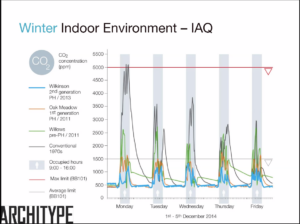Some solid work has been done in Aotearoa New Zealand by very capable architects and Passive House designers to design classrooms to Passive House performance levels. The fact none have yet been built is a sad reflection on prevailing attitudes in the Ministry of Education. Mechanical ventilation for consistent fresh air is getting stripped out at the so-called value engineering stage. What a signal that sends to people trying to create better environments for our children.
I don’t know how widespread this attitude is within the Ministry of Education. It could be it’s the uninformed beliefs of just a couple of people that are condemning several generations of kids to learning environments that harm their health and ability to learn. Perhaps the bias against continuous ventilation is more widely entrenched. But some positions badly need revising in light of hard scientific data. A post-occupancy review of five Passive House certified schools in the UK was published back in 2016 so it’s not like this information is a newsflash just in. The report is still full of valuable insights.
I also have a genuine question: is anyone monitoring indoor air quality in examination rooms, where we cram students in—and close doors and windows to make it quiet? These kids are doing their very best to perform in exams that might change the course of their future career and life trajectory. Are education providers supporting them in that goal? Because I’ve heard from an unimpeachable source that their unofficial and discreet check in one exam room indicated CO2 levels over 5000 ppm.
Let’s look at some evidence from the UK, where the first Passive House schools were built more than a decade ago. Currently there are 28 Passivhaus certified educational buildings (schools, colleges and university buildings). There’s no reason that would suggest New Zealand classrooms would be much different from the ordinary UK schools.
This data compares the indoor CO2 levels for three schools designed to different specifications. In summer, the difference in indoor air quality between Passive House and a typical 1970s-built classrooms is marked. Kids in the old classroom are regularly stuck inside with CO2 over 1500 ppm.

These graphs come from the case study of Wilkinson Primary School published by Architype in the UK. Follow the link for more context and interesting information about the different examples.
For a long time, the prevailing rule of thumb was that humans could operate OK in concentrations up to 1000 ppm of CO2. But as we reported in July last year, experts are now reconsidering whether that’s too high, with some research showing even 1000 ppm is negatively impacting human cognitive function.
But look at what happens in winter, when the windows presumably get closed tight. The carbon dioxide concentration in the old classroom is above 1500 all day and sails past 5000 ppm. And we act surprised when kids can’t focus and don’t learn?

Here’s a good summary of the impacts of CO2 on humans.
“Standards New Zealand Te Mana Tautikanga o Aotearoa set safe indoor CO2 levels at below 1000ppm:
- Tolerable exposure (1,000-1,400ppm) can cause a lack of focus, tiredness, impaired judgement and decision-making ability and fatigue
- Higher exposure (above 1,400ppm) can cause increased heart rate, headaches, dizziness, nausea and cognitive dysfunction
- Significant long-term health effects are not generally expected below 5000ppm.
These health impacts also adversely affect vulnerable populations such as young, elderly, and people with pre-existing respiratory conditions.”
I’m quoting from material published by, of all places, the Wellington City Library. It’s making decent CO2 meters available to borrow, so people can test indoor air quality in their homes. That’s commendably innovative
